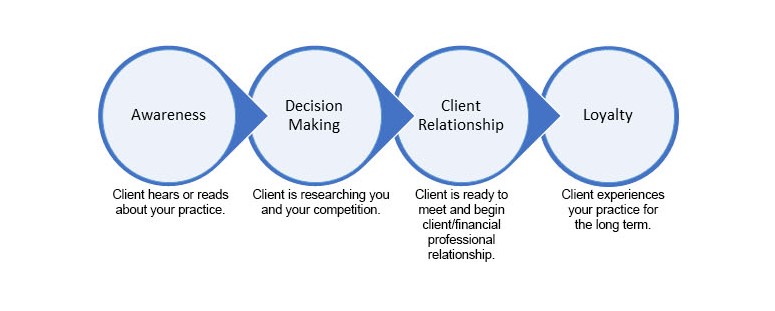A client experience map is the first step toward creating raving fans of your practice.
Oct 11, 2019 – Clients don’t become raving fans without an excellent experience along the way. The reality is that their expectations are only getting higher. And they have more options than ever for financial advice. Our Experience Map Template can help. By mapping the client journey, you can track the current experience and craft improvements. The resulting personalization and improved ease of business are keys to growing your practice.
A client experience map documents client interactions from awareness through loyalty. For each interaction, you rate the experience from the client’s point of view. You then note ways to improve (again from the client’s point of view). The map helps you identify client pain points. It’s the creative solutions you provide that act as your secret sauce.
Client Journey Stages

Mapping the Experience
It’s important to note that clients have different wants and needs at each stage of their journey. A potential client in the awareness stage isn’t looking for the same information as an existing client. When mapping the experience, you’ll want to take these differences into account. Do the same when rating each interaction.
Identifying client pain points can be challenging. It requires an understanding of what your clients want and an honest assessment of how your practice delivers on their expectations. The best way to understand what clients are experiencing is to ask them. You can also look for data to help support assumptions. If a client interaction rarely produces the desired outcome, that’s a good sign that there’s room to improve.
Another key piece of client experience mapping is identifying moments of truth. These are the few interactions that have the potential to make or break the client relationship. A good rule of thumb is to limit your moments of truth to one or two per stage of the client journey. This helps you zero in on the handful of touchpoints you must get right. Examples of moments of truth might include a prospective client researching your practice online, a first client meeting, or having to discuss tough news related to volatility or market declines.
Practical Tips
The Experience Map Template is an Excel document you can fill in to outline the current client journey and identify areas to improve. You might find it helpful to break the mapping project into four sequential parts:
- First, enter all client touchpoints for each stage of the journey.
- Then identify the few interactions that are moments of truth.
- Rate the client experience for each interaction.
- Recommend improvements last, paying extra attention to moments of truth.
It’s also worth engaging others when completing the map. This is definitely an exercise that benefits from diverse viewpoints and dialog. Take a vote when rating the client experience at each touch and average the responses. In the event of opposing views, a client survey can help identify what the experience is actually like. Differing client opinions may suggest an opportunity to further customize the experience.
Final Thoughts
A client experience map is a good tool to help document what your clients currently experience and identify areas to improve. Garnering deep insights requires client empathy and a desire to exceed expectations. When addressing client pain points, get creative and look for solutions aimed at personalization and ease of business. A bias toward action is also necessary. Once you have a great plan, be sure to put in place the changes and track results. You’ll be on your way to turning clients into loyal advocates for your practice.
CSC-0622-2226117-INV-E


